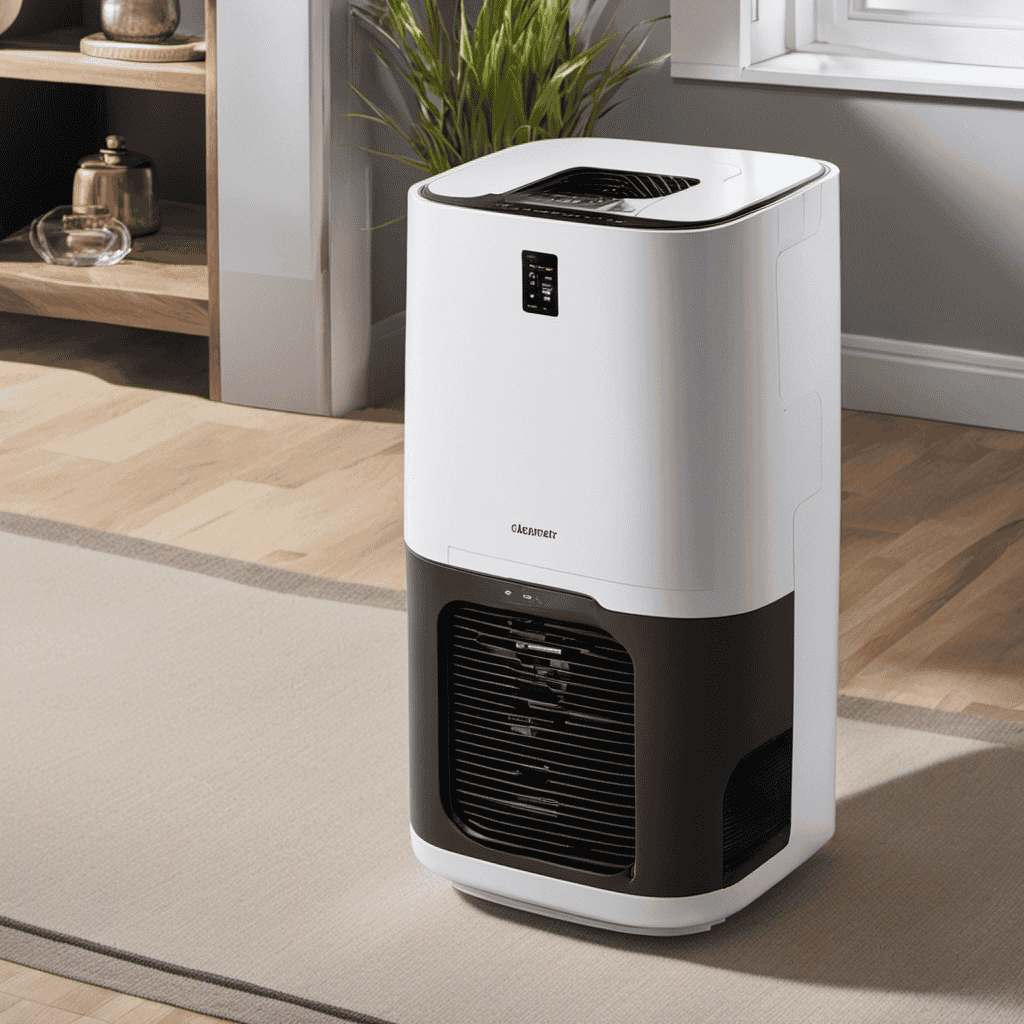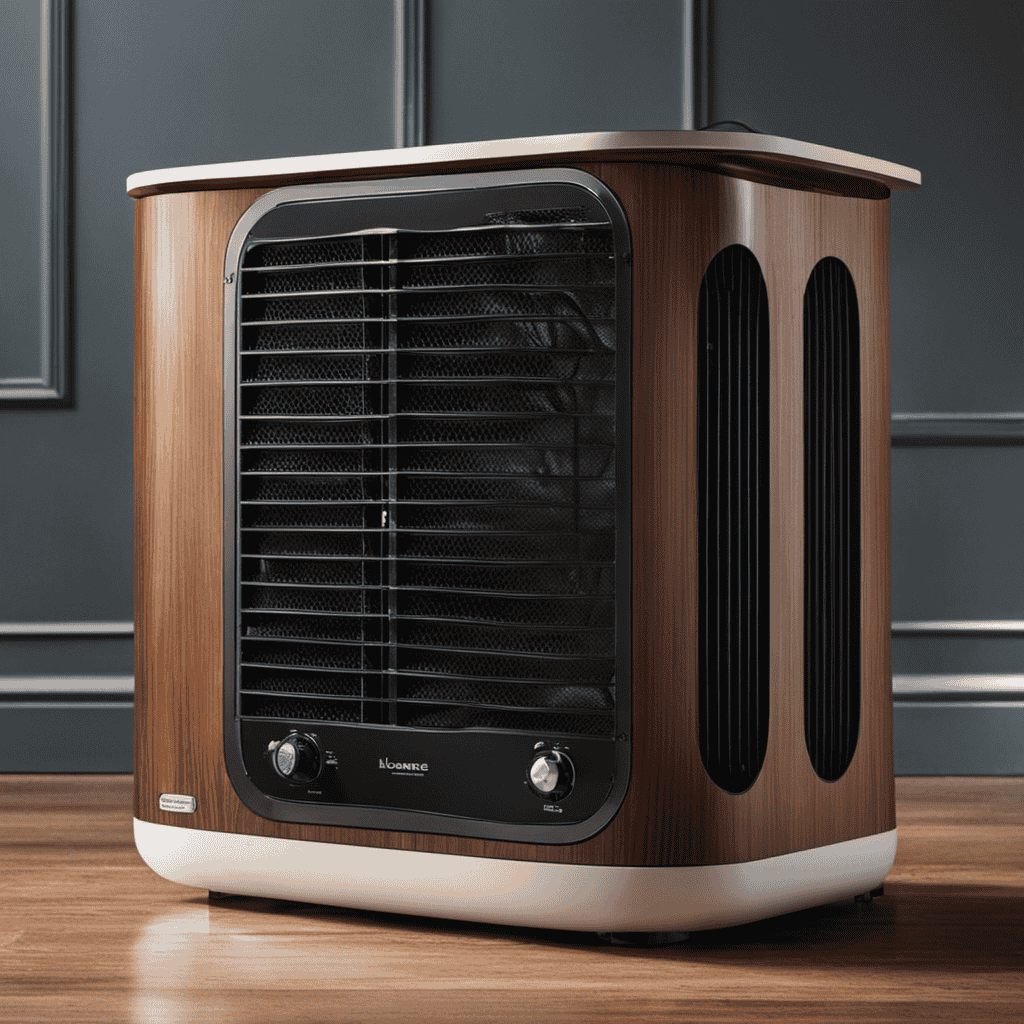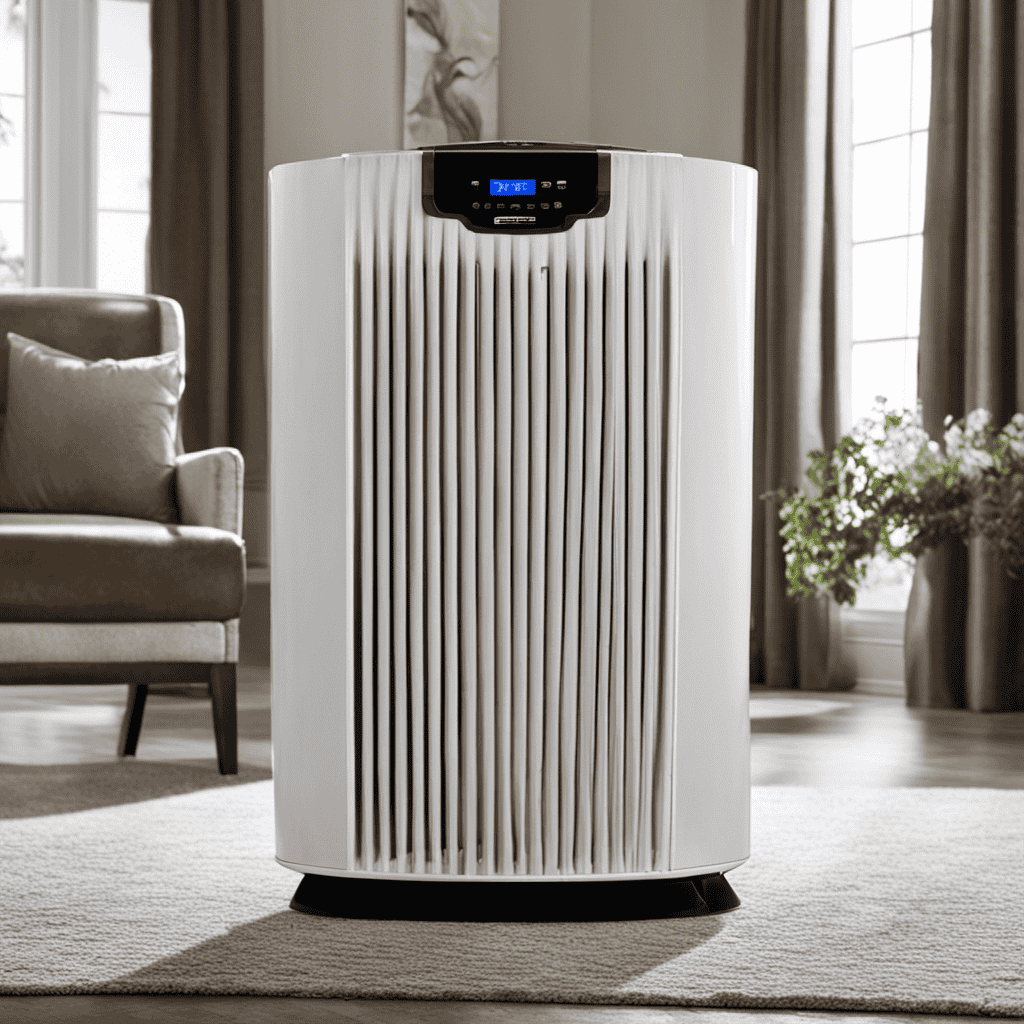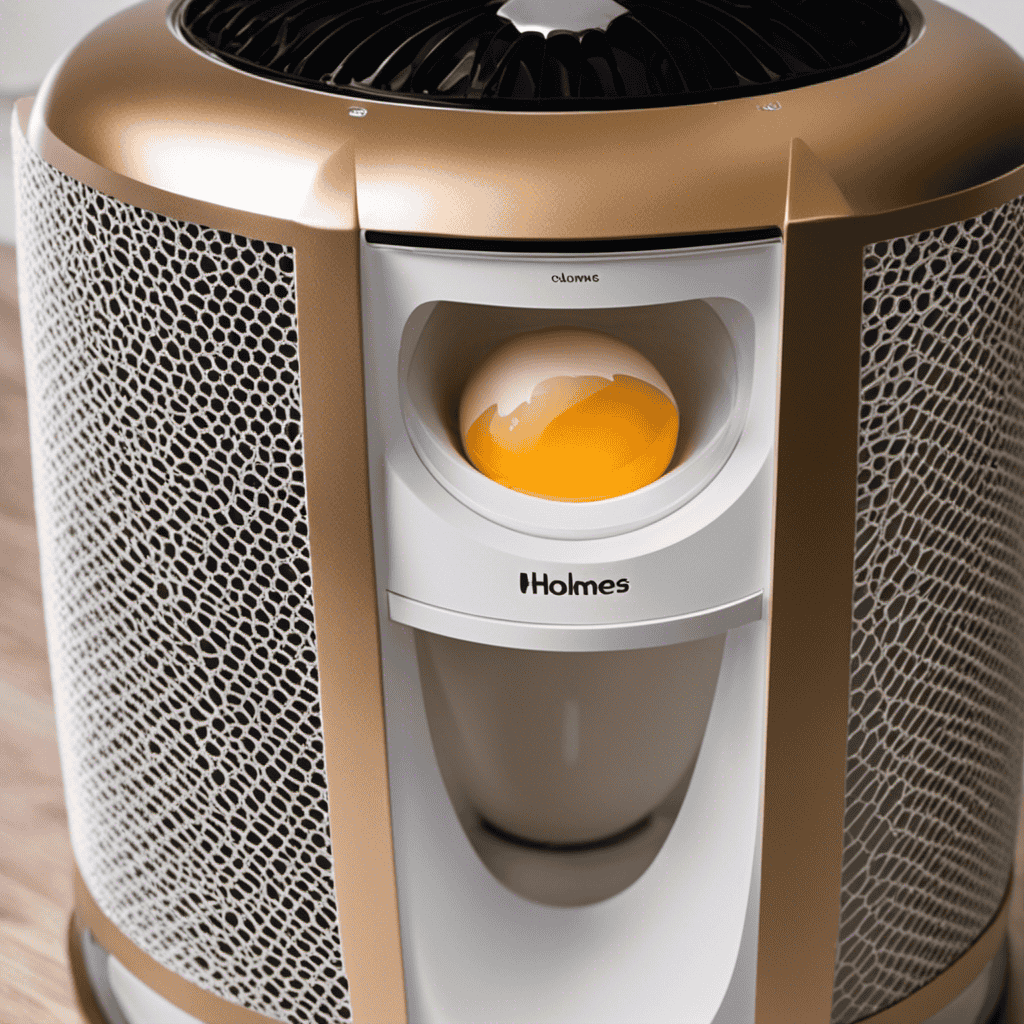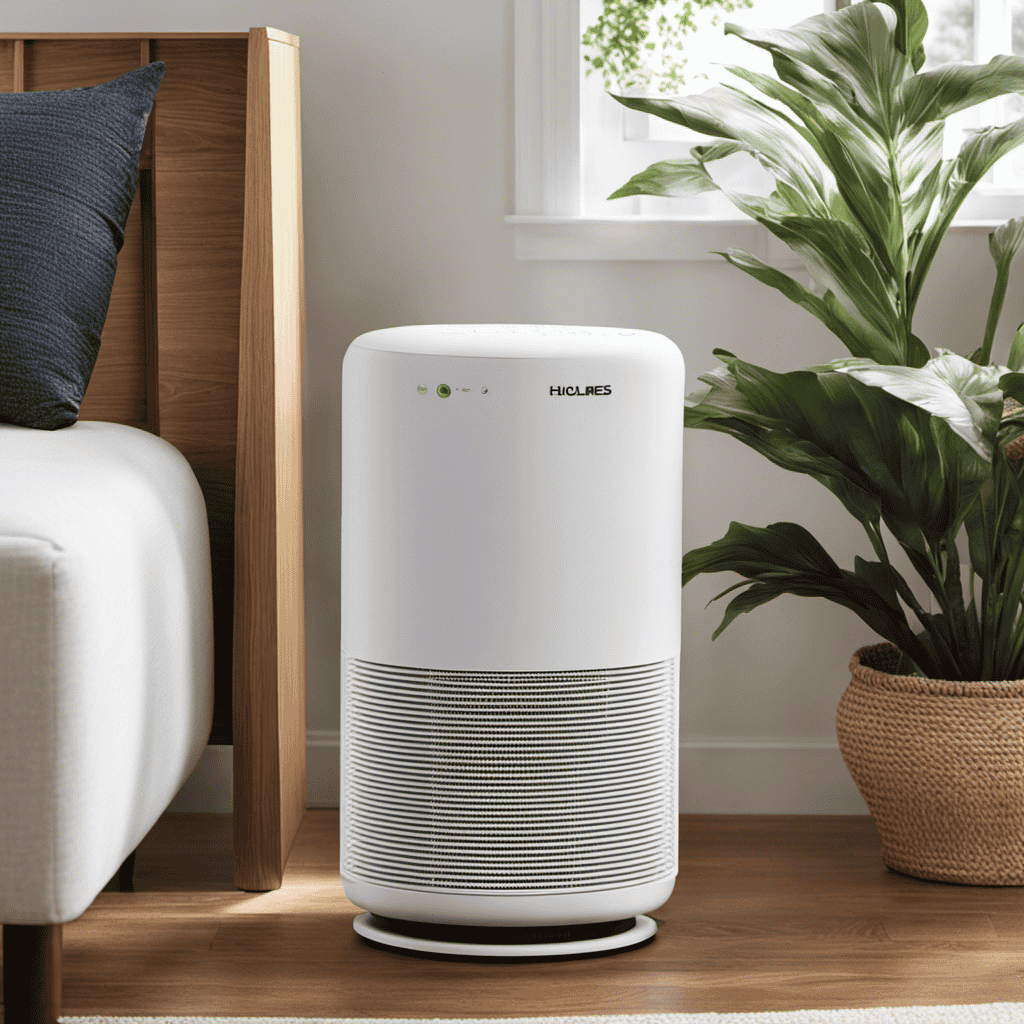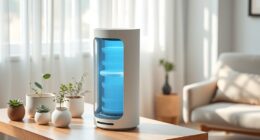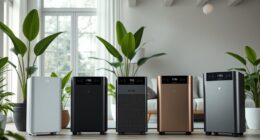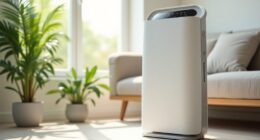In the world of air purifiers, it’s essential to have concrete proof that they are effectively removing pollutants. As the saying goes, ‘Seeing is believing!’
In this article, I will guide you through the key signs that indicate your air purifier is working effectively. From understanding different types of air purifiers to knowing the essential features and maintenance tips, we’ll dive into the science behind these devices.
Get ready to breathe in cleaner and fresher air!
Key Takeaways
- Improved indoor air quality and reduction of allergens and pollutants
- Various types of air purifiers with different features and functions
- Regular maintenance and troubleshooting are necessary for optimal performance
- Understanding air purifier filters and their effectiveness in removing pollutants is essential.
Importance of Air Purifiers
Air purifiers are important because they help improve indoor air quality. They play a crucial role in reducing allergens and improving respiratory health.
Allergens like dust mites, pollen, pet dander, and mold spores can trigger allergies and respiratory issues. Air purifiers work by capturing and filtering these contaminants from the air, preventing them from being inhaled. They use filters to trap particles and remove them from the air, ensuring cleaner and healthier indoor air.
For people with allergies, air purifiers can provide relief by reducing the presence of allergens in their environment. Additionally, air purifiers can help improve respiratory health by removing airborne pollutants like smoke, VOCs (volatile organic compounds), and harmful chemicals.
Types of Air Purifiers
To determine if an air purifier is effective, you can consider the different types available and assess which one suits your needs best. Air purifiers offer numerous benefits, such as improving indoor air quality, reducing allergies and asthma symptoms, and removing harmful pollutants like dust, pet dander, and smoke particles. The effectiveness of an air purifier largely depends on the type of filter it uses. There are four main types of filters commonly used in air purifiers: HEPA filters, activated carbon filters, UV filters, and ionizers. Each filter has its own unique way of trapping and eliminating pollutants from the air. To help you understand the differences, here is a table outlining the features and benefits of each filter type:
| Filter Type | Features | Benefits |
|---|---|---|
| HEPA | Traps 99.97% of particles | Removes allergens, dust, and pet dander |
| Activated Carbon | Absorbs odors and chemicals | Eliminates smoke and VOCs |
| UV | Uses ultraviolet light to kill germs | Destroys bacteria and viruses |
| Ionizers | Releases negative ions | Improves air freshness and neutralizes odors |
Key Features to Look for in an Air Purifier
When considering an air purifier, two key features to look for are effective air filtration and real-time air quality monitoring.
Effective air filtration ensures that the purifier is capable of removing a wide range of pollutants from the air, such as dust, allergens, and volatile organic compounds.
Real-time air quality monitoring allows you to monitor the quality of the air in your home or office and make adjustments as needed to maintain a healthy environment.
Effective Air Filtration
The most reliable way to determine if an air purifier is working is by checking the filter’s condition. The filter plays a crucial role in capturing and removing pollutants from the air, ensuring clean and healthy air to breathe.
Air purifiers offer numerous benefits, including improved air quality. Here are two sub-lists that highlight the emotional response to these benefits:
-
Improved Health and Well-being:
-
Reduced respiratory issues, such as allergies and asthma.
-
Relief from symptoms like coughing, sneezing, and congestion.
-
Peace of Mind:
-
Knowing that the air inside your home is free from harmful pollutants.
-
Creating a safe environment for your loved ones.
Understanding the importance of effective air filtration and the benefits it brings, we can now explore the next section, which focuses on real-time air quality monitoring.
Real-Time Air Quality
Real-time air quality can be monitored using specialized devices that provide accurate and up-to-date information. With recent advancements in air purifier technology, air quality monitoring has become more accessible and efficient.
These devices use various sensors to measure key pollutants in the air, such as particulate matter, volatile organic compounds, and carbon dioxide levels. By continuously monitoring these parameters, users can gain valuable insights into the quality of the air they breathe.
This information can help individuals make informed decisions about their indoor environment and take appropriate measures to improve air quality, such as using air purifiers. Understanding air purifier filters is crucial in ensuring their effectiveness in removing pollutants from the air.
Understanding Air Purifier Filters
When it comes to air purifiers, understanding the effectiveness of filters is crucial.
Filter effectiveness indicators, such as the Clean Air Delivery Rate (CADR), can help determine the efficiency of a filter in removing particles from the air.
Additionally, knowing when to replace dirty filters and how to properly maintain them is essential for optimal performance and clean air in your environment.
Filter Effectiveness Indicators
You can easily determine if an air purifier is working by checking its filter effectiveness indicators. These indicators are designed to show the level of filtration and the quality of air purification that the device is providing.
Here are two emotional responses that you may have when evaluating these indicators:
-
Relief: Seeing a high level of effectiveness on the indicator can bring a sense of relief, knowing that the air purifier is effectively removing indoor air pollution and creating a healthier environment for you and your loved ones.
-
Concern: On the other hand, a low level of effectiveness on the indicator may evoke concern, as it suggests that the air purifier is not effectively capturing pollutants and may need maintenance or a filter replacement.
Understanding the importance of filter effectiveness indicators helps us make informed decisions about the performance of our air purifiers and how to ensure clean and healthy indoor air.
Speaking of maintenance, the next section will discuss the importance of replacing dirty filters.
Replacing Dirty Filters
Replacing dirty filters is essential for maintaining the effectiveness of your air purifier and ensuring that it continues to provide clean and healthy indoor air. Regularly cleaning or replacing your air purifier filters is crucial in improving indoor air quality. A dirty filter can become clogged with dust, pollen, pet dander, and other airborne particles, reducing the purifier’s efficiency. To help you keep track of when to clean or replace your air purifier filters, here is a simple cleaning schedule:
| Filter Type | Cleaning Frequency |
|---|---|
| Pre-filter | Every 1-2 weeks |
| HEPA filter | Every 6-12 months |
| Carbon filter | Every 6-12 months |
Following this cleaning schedule will ensure that your air purifier is working optimally and effectively removing pollutants from your indoor air. By regularly replacing dirty filters, you can improve the overall indoor air quality in your home or office.
Filter Maintenance Tips
To effectively maintain your air purifier filters, it’s important to follow these filter maintenance tips.
-
Regularly clean the pre-filter: This is the first line of defense against larger particles and should be cleaned or replaced every 3 months to ensure optimal performance.
-
Change the HEPA filter: The HEPA filter captures tiny particles such as dust, pollen, and pet dander. Replace it every 6 to 12 months, or when the filter indicator light turns on.
-
Ensure proper installation: Make sure the filter is properly aligned and securely in place to prevent air leakage and maximize filtration efficiency.
-
Vacuum the filter housing: Dust and debris can accumulate in the filter housing, reducing airflow. Use a vacuum cleaner with a brush attachment to remove any buildup.
By following these maintenance tips, you can ensure that your air purifier functions efficiently, preventing common filter problems and improving the air quality in your home.
For air purifier troubleshooting, consult the manufacturer’s manual or contact customer support for assistance.
Signs That Your Air Purifier Is Effective
If you notice a decrease in sneezing and allergy symptoms, it’s a sign that your air purifier is working effectively. Air purifiers have numerous benefits, such as removing allergens, dust, and pollutants from the air, creating a cleaner and healthier indoor environment. However, some people may be concerned about the noise produced by air purifiers. Fortunately, many modern air purifiers are designed to operate quietly, allowing you to enjoy the benefits without any disturbance. To help you understand the effectiveness of your air purifier, I have created a table below that highlights the signs to look out for:
| Signs That Your Air Purifier Is Effective |
|---|
| Decreased sneezing and allergy symptoms |
| Reduced dust accumulation on surfaces |
| Fresher and cleaner indoor air |
| Improved breathing and respiratory health |
| Decreased odors |
Maintenance Tips for Air Purifiers
When cleaning your air purifier, make sure to unplug it from the power source to avoid any potential accidents.
Maintaining your air purifier is essential to ensure its optimal performance and longevity. Here are some maintenance tips to keep your air purifier in top condition:
- Regularly clean or replace the filters to prevent clogging and maintain the air purifier’s efficiency.
- Clean the exterior of the unit using a soft cloth and mild detergent to remove dust and dirt.
- Check the manufacturer’s instructions for specific cleaning recommendations for your air purifier model.
- Inspect the power cord for any signs of damage or wear and replace it if necessary.
- Ensure proper ventilation and avoid placing objects near the air purifier that may obstruct airflow.
Common Misconceptions About Air Purifiers
Contrary to popular belief, air purifiers are not capable of completely eliminating all indoor pollutants. While they are effective at reducing the concentration of certain contaminants in the air, they cannot eliminate them entirely.
One common misconception is that air purifiers can remove all types of odors. While they can help reduce odors caused by smoke or pets, they may not be as effective at removing odors from cooking or chemicals.
Another myth is that air purifiers can cure allergies. While they can help alleviate symptoms by reducing airborne allergens such as dust mites or pollen, they cannot cure allergies completely.
It is important to understand the limitations of air purifiers and use them as part of a comprehensive indoor air quality strategy, including regular cleaning and proper ventilation.
Conclusion
In conclusion, determining whether an air purifier is working is essential for maintaining a clean and healthy environment. By understanding the importance of air purifiers and their various types, as well as key features and filters to look for, we can ensure their effectiveness.
It is interesting to note that according to a study conducted by the American Lung Association, air purifiers can remove up to 99.97% of airborne particles, providing a visual representation of their efficiency in improving air quality.
Regular maintenance and debunking common misconceptions further optimize the performance of air purifiers.

